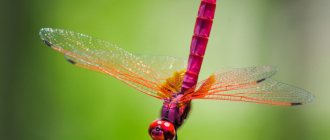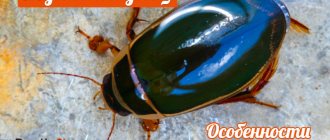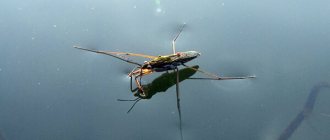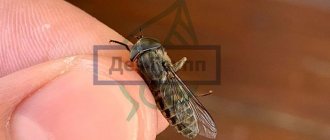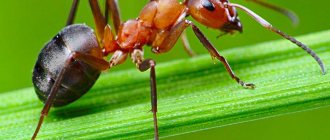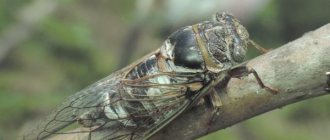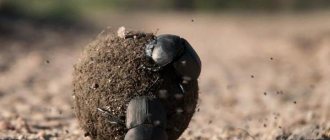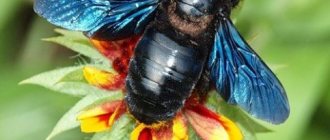Description and features
Dragonflies are flying predatory insects. They belong to the order of dragonflies, which has more than 6,000 species. The sizes of insects, depending on the species, range from 1.5 to 15 cm, and the wingspan is from 2 to 19 cm. The appearance of the dragonfly is easily recognizable. The insect has a large head with large eyes, short antennae, powerful mouthparts, chest, abdomen, three pairs of legs and two pairs of wings. Body color can be very different; dragonflies of various colors are found in the world. Some of them have a metallic sheen to their body.
Appearance
The dragonfly's head is very mobile and can rotate 180⁰. The eyes consist of a large number of facets (from 10 to 27 thousand). The lower rows of eye elements can only perceive the colors of objects, and the upper ones their shape. There are 3 simple eyes located on the crown. This structure and location of the eyes makes it possible for the dragonfly to survey the surrounding space not only in front of itself, it sees what is happening from the side, above and even behind.
But with the other senses the situation is much worse. Insects have a very weak sense of smell, and hearing is practically absent. The gnawing type oral apparatus is formed by strong, durable jaws, which are covered by the upper and lower lips.
The main feature that distinguishes dragonflies from other insects is their elongated abdomen, which makes up most of the body. The wings are large, transparent, consist of 2 layers of chitin and have many overlapping veins.
The tarsi consist of 3 segments, each of which is covered with small spines. The dragonfly needs its paws for grasping and holding prey, as well as for taking off and landing. Insects practically do not use them to move. During flight, the legs fold into the shape of a basket. This helps the insect instantly grab prey that gets in its way.
Vision
She has incredibly perfect, sharpest vision. The eyes are pierced with thirty thousand facets. For comparison, let's take the example of a fly, which also has exceptional vision. But it only has 6 thousand sides. Each of them creates a separate image. And thanks to the neuron cells in the insect’s brain, a complete picture of what he saw is formed.
We continue to talk about interesting facts about dragonflies. We humans perceive a certain color spectrum, and she is able to see not only it, but also distinguish objects in ultraviolet light. She is not afraid of even light polarization. When hovering over water, she is not blinded by water reflections. This allows you to maintain a confident course when hunting. Although if he falls under water, he will die because he will not be able to get out.
Kinds
All dragonflies are divided into 3 subspecies:
- Homoptera - this includes the smallest insects with an elegant body and wings of equal length;
- heteroptera - in this category, the rear pair of wings has an expanded base, thanks to which they can develop high speed;
- anisozygoptera is a rather rare group living in Japan, Nepal and Tibet; representatives of this subspecies combine the characteristics of the previous two.
The most common species of dragonflies belonging to Homoptera are:
- beauties;
- arrows;
- Lutki;
- planipedes.
The suborder heteroptera includes:
- grandfathers;
- grandmothers;
- rocker arms;
- club-bellies;
- Flat bellies.
Flat-bellied
All dragonflies are amphibious, that is, at different stages of development they live in water and on land. In the aquatic environment, eggs develop and larvae, which are otherwise called naiads, grow; the life activity of adults takes place in the air and on land.
Lifestyle and habitat
Dragonflies live in almost all corners of the globe; they are not found only in Antarctica, Greenland, Iceland and the islands of the Arctic Ocean. The wide distribution area is due to the ancient origin of insects, their ability to move quickly and over long distances, as well as the lack of food specialization.
Insects prefer warm regions with high humidity. Dragonflies live only in those areas where periods with stable negative temperatures last no more than 90-120 days.
The habitat of dragonflies is closely related to water bodies, since it is on water that females lay their eggs. The choice of pond is largely determined by the type of insect. These can be lakes, rivers, ponds and even flooded ravines or pits. The larvae, emerging from the eggs, grow and develop in water, and the adult dragonfly, having laid a clutch, can remain nearby or fly away over a long distance, measured in hundreds of kilometers, and most often the flights are made alone.
You can meet a dragonfly in nature in any open area, for example, on a forest edge or in a meadow. This is due to the fact that it is very important for the insect to be exposed to the sun. Dragonflies are diurnal, going out to hunt in the morning or evening. As night approaches, they hide in the grass or in the crown of trees.
Pairing
They don't have any mating season. The male simply selects, again in flight, the female and sharply attacks her. He takes her forcibly, clasping her with his paws, biting her in the back of the head. But she can mate with several males. But here there is an interesting fact about dragonflies. Before fertilization, each new owner pumps out the sperm of the previous male. It does this with the help of special teeth on the genitals. And everything happens in zero gravity.
It hatches up to two hundred eggs in one clutch, which is carried out on the foliage of trees growing above the surface of the water. The larvae simply develop in it. The larvae are predators that breathe using gills and eat small fish, bloodworms and tadpoles. They also take an extremely long time to develop: sometimes up to five years.
There are also interesting facts about dragonflies for children. For example, did you know that this insect is very ancient and has lived on the planet since the time of dinosaurs. It appeared about 300 million years ago. The dragonfly Meganeura had a wingspan of up to eighty centimeters. They themselves were incredibly huge in size.
Nutrition
Dragonflies are aggressive predators that pose a danger to many species of insects (mostly flying ones). They even attack those larger than them, and in most cases successfully. Interestingly, most species eat prey on the fly while in the air. They are very voracious, so they eat several dozen insects per day, the total weight of which significantly exceeds their own weight.
So, what do adult dragonflies eat:
- mosquitoes;
- flies;
- midges;
- beetles;
- spiders;
- moth;
- dragonflies.
These insects can be divided into several categories according to their hunting method:
- free upper tier predators - species that can fly high, lie in wait for prey at a height of 2 - 9 m above the ground;
- free hunters of the middle tier - hunt at a height of 0.5 - 2 m above the ground, most often circling over bodies of water, only occasionally resting on the grass or plants sticking out of the water;
- lying in wait hunters - sit in ambush on blades of grass or bushes, waiting for a prey flying past, and when they notice it, they suddenly take off and attack;
- grazing predators - hunt in thickets of grass, flitting from place to place in search of prey, having caught it, they eat it while sitting on a plant.
Dragonfly larvae feed on fish fry, leeches, insect larvae, tadpoles, and small crustaceans.
Order Homoptera
Order Homoptera. 30,000 species. Representatives: cicadas, aphids, etc.
Includes about 30 thousand species. They have two pairs of membranous wings of the same structure. The second pair is slightly smaller in size. They feed on plant juices. The oral apparatus is of the piercing-sucking type. Many plant pests are carriers of viral diseases.
Aphids belong to this order . They are small in size. Capable of reproducing parthenogenetically (without fertilization). They secrete a sugary substance that attracts ants. Ants feed on their secretions, spread aphids, and protect them. Cicadas are relatively large in size (5 cm or more). Capable of chirping to attract females. They are found mainly in the steppe zone.
Representatives: mountain cicada , etc.
Reproduction and lifespan
Dragonflies are insects with incomplete metamorphosis; they skip the pupal stage. The life cycle of a dragonfly includes three stages:
- egg;
- larva;
- imago.
Larva
Depending on the species, reproduction of dragonflies can occur 1 or several times a year. Before mating, males unite in groups and begin to look for partners. Coitus occurs in the air and can last from a few seconds to 2-3 hours. The insects spend this time clinging together, hovering in the air.
The fertilized female goes to the nearest suitable body of water, where she lays eggs in an amount of from 100 to 600 pieces. Masonry is most often done on plants that rise above the water or are located under it. The larvae hatch within a few weeks. The entire life of a dragonfly larva is spent in water. They actively hunt, feed and grow. At this stage, the insect experiences from 5 to 15 molts.
The duration of development during the larval stage largely depends on the availability of sufficient food. It can take from several months to several years before becoming an adult.
When the time comes to move to the adult stage, the larva crawls out of the water (along a plant stem, stone, snag) and remains in the air from several hours to several days. At this time, she begins to breathe atmospheric air, frees herself from the shell under which the wings were hidden.
Natural enemies of dragonflies
Due to the fact that larvae and adult insects live in different environments, their enemies are also different. The danger for larvae is:
- predatory and omnivorous fish;
- birds living on shallows and near bodies of water (herons, waders, etc.);
- swimming beetles and their larvae;
- some species of water bugs.
Adult dragonflies are hunted by:
- orb-weaving spiders, tetragnathid spiders, hobo spiders;
- blackflies;
- birds (including bee-eater, white wagtail, gulls, ducks, swifts, woodpeckers).
Enemy of the dragonfly
In addition, dragonflies can become prey for carnivorous plants. Most often these are varieties of sundews growing in sphagnum and peat bogs. To date, no enemies of dragonflies have been found among mammals and reptiles.
Considering that adult insects are quite cautious, fly quickly and maneuver deftly in the air, it is not easy to catch them. A predator can eat a dragonfly only if it takes the insect by surprise, which does not happen often.
The benefits and harms of dragonflies
Like many other insects, dragonflies cannot be called clearly beneficial or harmful. Their benefit is that adult individuals feed on insects, and therefore play a significant role in the regulation of certain types of blood-sucking insects (including such dangerous ones as horseflies or tsetse flies), pests of agricultural crops and forests. In addition, dragonflies participate in pollination. Flying from flower to flower, they carry pollen on their legs. Fish and crustaceans feed on the larvae of these insects. Fishermen often use them as bait.
Damage is caused mainly by dragonfly larvae. They eat the fry of some fish species or compete with them for food, which leads to a decrease in the population. In addition, the larvae are hosts for parasites, in particular helminths. Birds (including domestic birds) eating larvae can become infected with prostagonymosis. This is a serious disease that affects the bird's ability to lay eggs. Without timely, competent treatment, there is a high risk of death.
Option 2
A dragonfly is a flying insect. Dragonflies are predators despite the fact that they are most often seen on plants and flowers. They feed on small insects, which they catch in flight. Scientists identify more than 6,500 species. Several species are listed in the Red Book of some countries, others have already become extinct.
These insects have inhabited the planet for a long time. Geologists find their prints on stones and remains in amber. And in 1939, traces of a giant dragonfly were found in the USA. Its wingspan was 71 cm, and its length was about 30 cm.
Interesting facts about these insects:
3rd grade The world around us. 7th grade Biology
